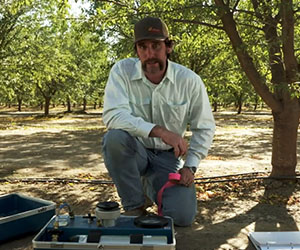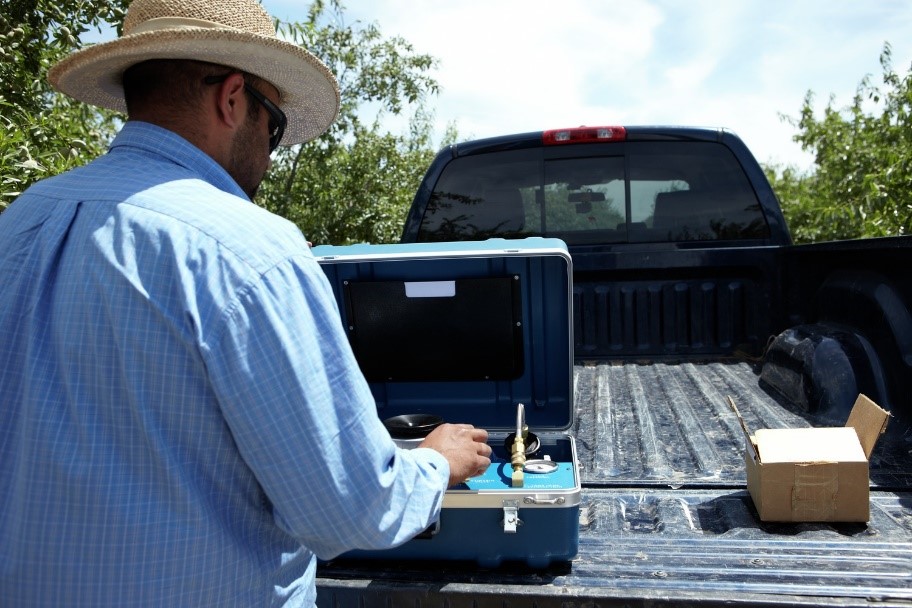Pressure chamber monitoring prior to hullsplit improves irrigation precision, helps manage hull rot
If you hop in your truck before a road trip without knowing how much fuel you have in the tank, you may find yourself in a sticky situation down the road. Limiting irrigation without first understanding plant-water status can lead to similar pitfalls. Just like the fuel gauge shows how much gas is left, a pressure chamber offers a real-time look at the needs of an orchard.
And, around hullsplit, accurate data on plant water status is especially valuable.
 A pressure chamber is a quantitative method for measuring plant water status, with relationships established between pressure chamber measurements and tree growth and productivity.
A pressure chamber is a quantitative method for measuring plant water status, with relationships established between pressure chamber measurements and tree growth and productivity.
A plant-based strategy, known as managed deficit irrigation (MDI) and regulated deficit irrigation, reduces water use during crop stages with higher stress tolerances. Leveraging MDI effectively can manage hull rot, increase water use efficiency and promote uniform hullsplit, leading to an earlier harvest and lower navel orangeworm (NOW) exposure, with no long-term impact on yield. The numbers speak for themselves — depending on soil type, MDI can result in an annual water savings of 10–50%, and hull rot can be reduced by 60–90% if leveraged between post-kernel fill and 90% hullsplit. Earlier harvests can mean getting nuts out of the orchard before third NOW flight, which typically occurs in early August.
The success of it all, however, hinges on accurately knowing your starting point.
Spencer Cooper, senior manager, irrigation and water efficiency, Almond Board of California, and Luke Milliron, UCCE Farm Advisor for Butte, Glenn & Tehama counties, regularly consult with growers on their irrigation practices. They know firsthand the importance of accurate data.
“Without a pressure chamber, you’re essentially flying blind,” said Milliron. “Even if you know how much water you applied, what your soil holds and what’s lost through evapotranspiration, you still might not have the complete picture of where you’re standing.”
“No matter if you’re trying to improve quality or reduce water use, the pressure chamber is the best way to find out what’s going on within the plant,” said Cooper. “From there, growers can leverage MDI in a way that maximizes benefits without sacrificing yield.”
Getting started with a pressure chamber can seem like a daunting task, but the research community has done much of the footwork, producing many helpful how-to guides and videos. The UC Davis Fruit and Nut Research and Information Center offers an introduction to the pressure chamber and a video by PMS Instrument Company demonstrates the use of one popular model. For a more in-depth review, growers can reference the UC ANR Publication 8503, “Using the Pressure Chamber for Irrigation Management in Walnut, Almond, and Prune” and the Almond Irrigation Improvement Continuum from the Almond Board of California.
In addition to resources available online, Cooper and Milliron stress how learning from peers can be helpful.
“The best way to learn is through consulting with someone familiar with the pressure chamber, be it a crop advisor, university specialist or fellow grower,” said Cooper. “In 30 minutes to an hour, you can learn what you need to be effective.”
After nailing down the technique, gathering the readings themselves can be an easy task that only takes a few minutes and can be completed alongside other orchard management needs.
 Keeping a pressure chamber in the truck makes it easy to gather data during check ups in the orchard.
Keeping a pressure chamber in the truck makes it easy to gather data during check ups in the orchard.
“Growers are already in the orchard, walking the field and checking on their crop,” Milliron said. “Keep the pressure chamber in the truck, and it’ll be a quick, simple measure to add to the routine.”
By dialing into the individual water needs of almond trees at a specific moment, growers can unlock a world of data that may help them better produce a high-quality crop. The more data, the more informed irrigation scheduling decisions can be — even a few readings is enough to provide insights otherwise unknown.
The Almond Irrigation Improvement Continuum offers growers a path to advance their plant water status monitoring. Moving from subjective visual cues to objective measurements from a pressure chamber, the Continuum helps growers improve accuracy and incrementally increase how often measurements are taken. The Continuum also explains how to confidently interpret your pressure chamber results, accounting for stage and weather conditions.
“Growers know the value of informed decision making,” Cooper said. “The pressure chamber is a powerful plant-based monitoring tool that makes precision irrigation and practices like MDI possible.”
For a hands-on demonstration on using a pressure chamber, or to learn more about the Almond Irrigation Improvement Continuum, almond growers can request a free in-orchard consultation. Contact Spencer Cooper at scooper@almondboard.com or (209) 604-3727 to schedule.